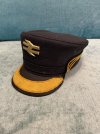Intercity 225
Member
- Joined
- 2 Mar 2014
- Messages
- 329
Hi,
I've recently inherited this hat, it was formerly my Grandfather's who we sadly lost about 15 years ago. Regrettably, my Grandmother also died recently and upon clearing out their house we discovered a large box of railwayana, which amongst other items, contained this hat.
As the remaining railway enthusiast in the family, this box has now been given to me. Most of the items are self-explanatory but I can't seem to find another version of this hat online - I can find similar ones but the markings look different. My Grandfather worked on the railway for over forty years between the 1950s and 1980s in a wide variety of roles but the double arrow suggests that it must be from 1965 onwards. During that time I know that he worked as a Station Master and also with military/dangerous goods trains but apart from that I'm a bit stuck.
All advice appreciated.
Many Thanks
I've recently inherited this hat, it was formerly my Grandfather's who we sadly lost about 15 years ago. Regrettably, my Grandmother also died recently and upon clearing out their house we discovered a large box of railwayana, which amongst other items, contained this hat.
As the remaining railway enthusiast in the family, this box has now been given to me. Most of the items are self-explanatory but I can't seem to find another version of this hat online - I can find similar ones but the markings look different. My Grandfather worked on the railway for over forty years between the 1950s and 1980s in a wide variety of roles but the double arrow suggests that it must be from 1965 onwards. During that time I know that he worked as a Station Master and also with military/dangerous goods trains but apart from that I'm a bit stuck.
All advice appreciated.
Many Thanks


